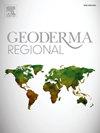提高农业生态系统的可持续性:日本安多索尔地区再生有机大豆生产的综合土壤健康策略
IF 3.3
2区 农林科学
Q2 SOIL SCIENCE
引用次数: 0
摘要
再生农业优先考虑土壤健康,以提高生态系统和作物产量。采用覆盖作物轮作的免耕有机农业提高了可持续性。但是,必须考虑到经济障碍。本研究评估了生物炭与覆盖作物长期免耕结合作为一种可再生有机方法对土壤健康和碳封存的影响,并评估了该耕作系统的经济可行性。田间试验设计为随机完整区,采用分畦式布置,分为4个重复,包括不同的耕作方式(免耕、旋耕机和犁板耕作)、覆盖作物(黑麦、毛杨和休耕)和生物炭应用(加和不加生物炭)。该研究还包括两种种植情景,大豆和大豆+水稻生产,以进行经济分析。结果表明:连作免耕轮作中添加生物炭增加了表层(0 ~ 30 cm)土壤有机碳及其储量,通过降低土壤容重和抗渗性改善土壤健康指标,增加微生物活性,促进养分循环。免耕制度下大豆产量变化较大,造成效益成本比较低;然而,在以有机农业为基础的免耕管理中,大豆与水稻的一体化生产提高了这一比例。黑麦免耕与犁耕相比,土壤有机碳生产成本最低。鉴于这些发现,将生物炭纳入以再生有机农业为中心的长期免耕管理将改善环境质量,提供经济优势,增强自然系统的恢复力,特别是在日本的Andosol。本文章由计算机程序翻译,如有差异,请以英文原文为准。
Enhancing agroecosystem sustainability: Integrative soil health strategies in regenerative organic soybean production on Andosol in Japan
Regenerative agriculture prioritizes soil health to enhance ecosystems and crop production. No-tillage organic farming with cover crop rotation improves sustainability. However, economic barriers must be considered. This study evaluated the involvement of biochar into long-term no-tillage combined with cover crop as a regenerative organic approach on soil health and carbon sequestration as well as to assess the economic viability of this farming system. The field experiment was designed as a randomized complete block with a split–split plot arrangement consisting of different tillage practices (no-tillage, rotary cultivator, and moldboard plowing), cover crop (rye, hairy vetch, and fallow), and biochar applications (with and without biochar), in four replications. The study also included two farming scenarios, soybean and soybean + rice production, for economic analysis. Results showed that incorporating biochar into the continuous no-tillage with cover crop rotation increased soil organic carbon and its stock in the topsoil profile (0–30 cm), improved soil health indicators by reducing soil bulk density and penetration resistance, and increased microbial activity, thereby promoting nutrient cycling. Soybean yield varied under the no-tillage system, resulting in a low benefit–cost ratio; however, the integration of soybean with rice production improved this ratio in organic farming–based no-tillage management. Compared with moldboard plowing, no-tillage with rye resulted in the lowest cost of soil organic carbon production. Given these findings, integrating biochar into long-term no-tillage management centered on regenerative organic farming would improve environmental quality and provide economic advantages, strengthening the resilience of natural system, specifically in Andosol, Japan.
求助全文
通过发布文献求助,成功后即可免费获取论文全文。
去求助
来源期刊

Geoderma Regional
Agricultural and Biological Sciences-Soil Science
CiteScore
6.10
自引率
7.30%
发文量
122
审稿时长
76 days
期刊介绍:
Global issues require studies and solutions on national and regional levels. Geoderma Regional focuses on studies that increase understanding and advance our scientific knowledge of soils in all regions of the world. The journal embraces every aspect of soil science and welcomes reviews of regional progress.
 求助内容:
求助内容: 应助结果提醒方式:
应助结果提醒方式:


